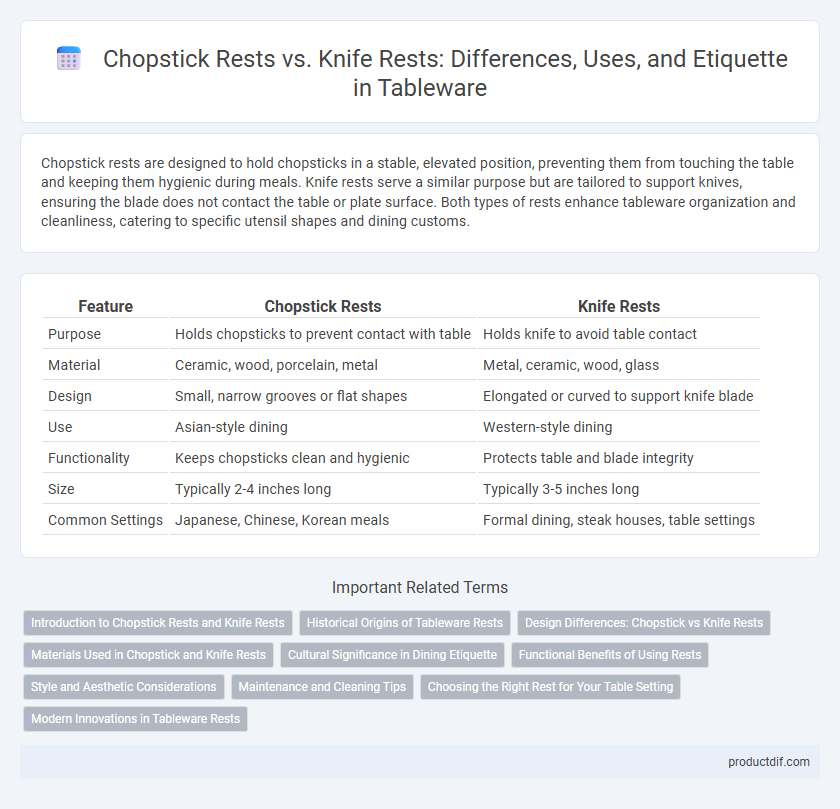Chopstick rests are designed to hold chopsticks in a stable, elevated position, preventing them from touching the table and keeping them hygienic during meals. Knife rests serve a similar purpose but are tailored to support knives, ensuring the blade does not contact the table or plate surface. Both types of rests enhance tableware organization and cleanliness, catering to specific utensil shapes and dining customs.
Table of Comparison
| Feature | Chopstick Rests | Knife Rests |
|---|---|---|
| Purpose | Holds chopsticks to prevent contact with table | Holds knife to avoid table contact |
| Material | Ceramic, wood, porcelain, metal | Metal, ceramic, wood, glass |
| Design | Small, narrow grooves or flat shapes | Elongated or curved to support knife blade |
| Use | Asian-style dining | Western-style dining |
| Functionality | Keeps chopsticks clean and hygienic | Protects table and blade integrity |
| Size | Typically 2-4 inches long | Typically 3-5 inches long |
| Common Settings | Japanese, Chinese, Korean meals | Formal dining, steak houses, table settings |
Introduction to Chopstick Rests and Knife Rests
Chopstick rests and knife rests serve as functional and decorative tableware accessories designed to keep utensils clean and prevent contact with the dining surface. Chopstick rests are small supports, often made from ceramic, wood, or metal, specifically crafted to hold chopsticks, maintaining hygiene in East Asian dining traditions. Knife rests, typically crafted from materials like silver, porcelain, or glass, provide a dedicated spot for knives during Western meals, enhancing table etiquette and protecting table linens from knife stains.
Historical Origins of Tableware Rests
Chopstick rests originated in East Asian cultures, particularly Japan and China, where they were designed to keep chopsticks elevated and hygienic during meals. Knife rests emerged in Western dining traditions, dating back to the 18th century, aimed at preventing knives from smearing tablecloths or contaminating surfaces. Both types of rests highlight the cultural importance of maintaining cleanliness and order in historical dining etiquette.
Design Differences: Chopstick vs Knife Rests
Chopstick rests typically feature slender, elongated designs to securely hold chopsticks, often incorporating grooves or curved surfaces that prevent slipping. Knife rests are generally stouter with flat or slightly curved platforms designed to support heavier, broader knife blades without damaging the tablecloth. The contrasting shapes reflect the functional requirements of stabilizing slim chopsticks versus bulkier knives, influencing material choice and aesthetic styles in tableware sets.
Materials Used in Chopstick and Knife Rests
Chopstick rests are commonly crafted from materials such as ceramic, porcelain, wood, bamboo, and lacquer, emphasizing lightweight and heat-resistant properties to support delicate chopsticks. Knife rests often utilize sturdier materials like stainless steel, brass, glass, or stone to provide stable support for heavier, metal knife blades. Both types of rests may feature designs that complement table settings but prioritize material durability suited to the specific utensils they hold.
Cultural Significance in Dining Etiquette
Chopstick rests hold cultural significance in East Asian dining etiquette by symbolizing respect for cleanliness and proper table manners, ensuring chopsticks do not touch the table or each other. Knife rests, prominent in Western dining traditions, serve a similar purpose by keeping knives elevated to maintain hygiene and signify formality during multi-course meals. Both rests reflect cultural values surrounding respect, order, and refinement in their respective culinary customs.
Functional Benefits of Using Rests
Chopstick rests prevent chopsticks from rolling off the table and keep their tips sanitary by elevating them above the surface, enhancing hygiene and convenience during meals. Knife rests maintain the cleanliness of tablecloths and surfaces by providing a designated spot to place knives, preventing smudges and scratches. Both types of rests improve overall table aesthetics and organization, contributing to a refined dining experience.
Style and Aesthetic Considerations
Chopstick rests often feature minimalist designs with delicate curves and subtle textures, complementing Japanese or Asian-inspired tableware aesthetics. Knife rests typically exhibit a more robust and structured appearance, aligning with Western dining themes and heavier dinnerware sets. Selecting the appropriate rest enhances the overall table setting by reinforcing the cultural style and elevating visual harmony between utensils and serving dishes.
Maintenance and Cleaning Tips
Chopstick rests and knife rests require regular cleaning to maintain hygiene and appearance, preferably with warm soapy water after each use to prevent residue buildup. Materials such as ceramic and stainless steel are easier to clean and more resistant to stains, while wooden rests need gentle hand washing and thorough drying to avoid warping or cracking. Avoid abrasive cleaners and soaking wooden rests to preserve their integrity and extend their lifespan.
Choosing the Right Rest for Your Table Setting
Choosing the right rest for your table setting depends on the utensils used and the style you aim to achieve; chopstick rests offer an elegant solution for Asian cuisine while knife rests enhance Western formal dining by keeping blades off the tablecloth. Material and design also play crucial roles, with porcelain and ceramic options commonly favored for their durability and aesthetic appeal. Selecting a rest that complements your tableware enhances both functionality and visual harmony in your dining experience.
Modern Innovations in Tableware Rests
Chopstick rests and knife rests have evolved through modern innovations in tableware, incorporating minimalist designs and sustainable materials such as bamboo, stainless steel, and biodegradable polymers. Contemporary rests often feature multifunctional properties, including antibacterial coatings and ergonomic shapes to enhance dining hygiene and comfort. Advances in 3D printing technology enable customized shapes and textures, merging aesthetics with practical utility for sophisticated table settings.
Chopstick Rests vs Knife Rests Infographic

 productdif.com
productdif.com